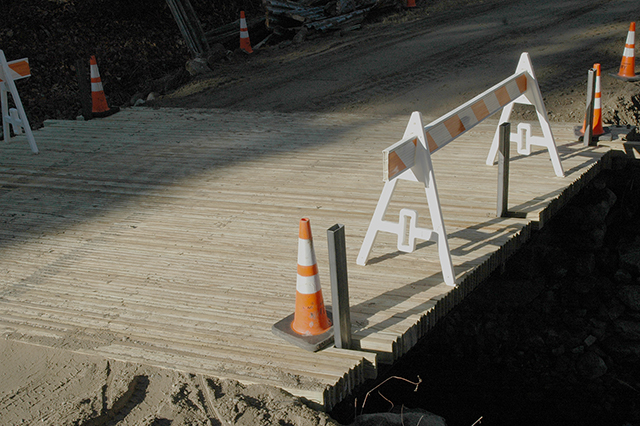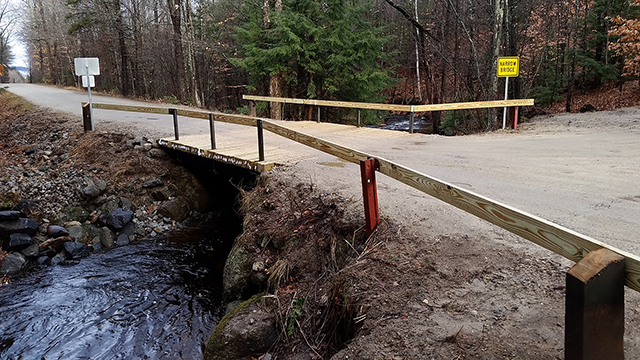
When the 2015 Town Meeting voted to hire the Town’s first part-time Highway Department employees, voters were attracted by the promise of getting work done around town without having to pay contractor’s rates to do it. When the voters approved the 2016 budget making those employees full-time, they didn’t realize they weren’t just voting for more of the same savings.
The recent project to rebuild the Kearsarge Mountain Road bridge has shown that there’s another very substantial benefit to the Town having one or more full-time Highway Department employees: the ability to undertake straightforward road projects without the expense of an engineer’s stamp.
Discovering that “hidden” bonus started early this fall, when state bridge inspectors contacted the Town with dire news: the small bridge near the top of Kearsarge Mountain Road would have to be rebuilt right away.
For a town that has no Highway Department employees, unwelcome news like that would set off a long and expensive chain of events, beginning with perhaps thousands of dollars of engineering studies to get an approved set of drawings. Months (or years) later, when Department of Transportation (DOT) funding becomes available, it would be time to collect bids from contractors to execute the plan, perhaps to the tune of hundreds of thousands of dollars, of which the town would have to pay 20%.
But the rules for a town that has one or more Highway Department employees are different. If the Select Board and the Road Agent (whether elected or employed) are comfortable with the scope and complexity of the project, they can forgo the engineering study, the approved drawings, the state funding, and the bidding process – and the long delays and high price tags associated with each of those steps.
Instead, as Andover did recently with the Kearsarge Mountain Road bridge, they can simply “get ‘er done” using the Town’s and the Road Agent’s own resources. The delays are minimal, and the costs are dramatically less.
The only downside is that the Town “owns” the project – if something should go wrong with the bridge in the future, there’s no engineer onto whom to try to shift the liability.
Done in a Day
The Kearsarge Mountain Road project took about six weeks from the time the state raised the alarm until the project was complete. The process was straightforward: the Road Agent took all the relevant data about the bridge to Cohen Steel Supply in Concord, where their in-house engineer did the calculations to come up with the products and a plan that would not only fix the bridge, but increase its load-bearing capacity by 6,600 pounds.
DOT was very happy to review the plan, and it found no flaws, so the project was good to go, with no engineering studies, no engineering stamp, and no huge engineering bill – just a plan and a truckload of the appropriate materials.
The construction itself was completed in a single long day. According to Road Agent John “Tiny” Thompson, Highway Department employees Jim Reed and Keith Blinn and the Road Agent’s crew “worked like a well-oiled machine” to prepare for the big day and then execute the plan, wrapping up after nightfall on the day they started.
Tiny also credits the Select Board and Town Administrator Marj Roy for thinking outside the box and trying this new (for Andover) approach to bridge projects. “It was a real team effort,” he says, with lots of good ideas and helpful information sharing.
The Question of Liability
The new approach used on Kearsarge Mountain Road is made possible by the fact that Andover now has full-time Highway Department employees and therefore falls under a different set of rules than it did before, allowing it to skip the formal engineering studies and to treat the Road Agent as part of the Town, rather than as a contractor.
But there’s one more difference between the two approaches to consider: liability.
If something were to go wrong with the Kearsarge Mountain Road bridge years from now and the Town were sued, the Town would have no recourse – there’s no engineer’s stamp and therefore no engineer onto whom to try to shift some or all of the liability; and there’s no contractor to blame, because in this new approach, the Road Agent is considered part of the Town.
So while the new approach offers some compelling benefits, it does have its dark side, which leaves the townspeople and the Select Board to contemplate how much risk it’s appropriate for the Town to assume, and how much time and money we need to save to make it worth assuming that risk.
As it turns out, there’s no free lunch; but even years from now the Kearsarge Mountain Road bridge project will probably prove to have been a pretty tasty morsel nonetheless.



